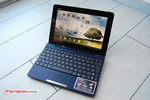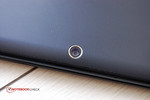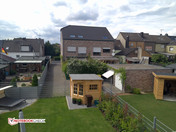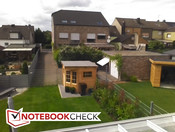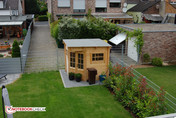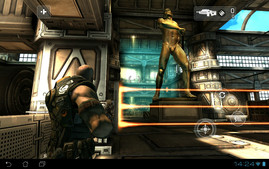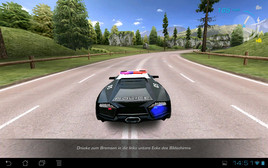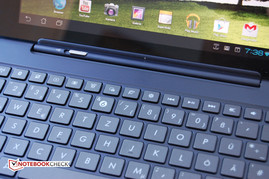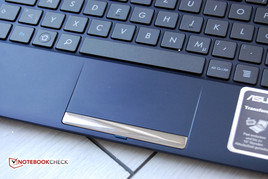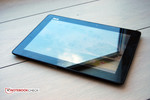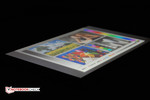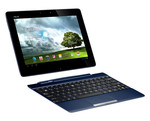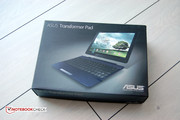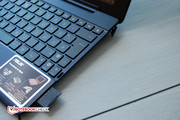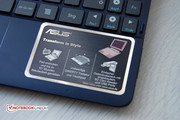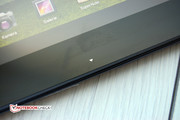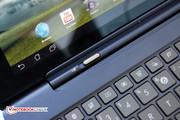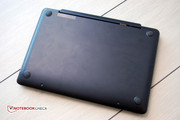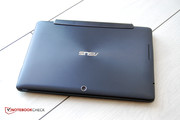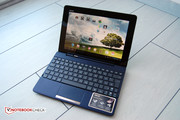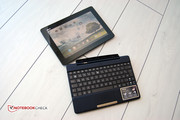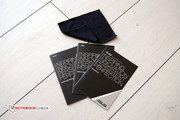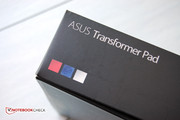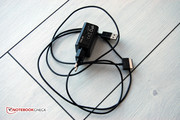Review Asus Transformer Pad TF300T Tablet/MID

The Asus Transformer Pad family has been designed based on the principle of being both tablet PC and netbook in one device and this principle has proven successful. The TF300 series is the latest addition to the Transformer Pad family and includes three versions – a Wi-Fi only version (TF300T), a 3G-enabled version (TF300TG), and an LTE version (TF300TL). All three versions use the quad-core Nvidia Tegra 3 SoC (System on a Chip) and Android 4.0 operating system. The LTE model is the first Transformer Pad to feature LTE support and, according to manufacturer specifications, makes use of available LTE frequencies in Germany. Our test sample is the TF300T Wi-Fi only model which was delivered with a docking keyboard. In this review, we will determine if the TF300T is a well-designed tablet.
Case
We received the Asus Transformer Pad TF300T bundle that includes both the tablet and its docking keyboard. On its own, the TF300T weighs 635 grams (1.40 pounds) and has a modest 10 mm (0.39 inches) thickness. These dimensions ensure ease of handling during tablet use. When paired with the docking keyboard, the 10.1-inch tablet weighs in at an approximate weight of 1200 grams (2.64 pounds) and the resulting system is quite similar to a flat netbook. Despite its netbook-like appearance, the TF300T remains a tablet PC with a cutting-edge CPU and an equally modern operating system to match.
The TF300T uses the latest quad-core Nvidia Tegra 3 SoC (System on Chip). This processor operates at 1.5 GHz in single-core operation and 1.4 GHz when utilizing multiple cores. An additional, fifth “Power-Saver” core is used in place of the quad-core processor for less demanding tasks such as standby mode and playing music, allowing the system to use less power in these situations. The SoC is paired with 1 GB RAM and the device is equipped with 32 GB of flash storage.
The Asus Transformer Pad is available in white, red, and blue. Our test model is blue and has, by far, the most conservative appearance of the entire line-up. Nonetheless, the variety allows the TF300T Transformer Pad to distinguish itself from the many competing tablets that are available only in black, silver, or grey. Asus chose synthetic materials instead of aluminum for the case of this model. While some may consider this a cost-cutting measure, the workmanship of the case is nonetheless flawless even if the sturdiness could be somewhat improved. Our test sample exhibited a few creaks under selective pressure and pressure to the display area caused the liquid crystals to react visibly. The device felt good in our hands and has an elegant yet simple profile. The front side of the device is little more than the display glass and has no buttons or keys. A webcam is placed on the upper display frame next to the brightness sensor. On the bottom edge, near the middle, a small arrow indicates the proper position for connecting the docking keyboard.
For the purpose of this review, we will describe the layout of the keys and ports of the TF300T as seen in the landscape orientation. The power button has a clear pressure point and is located on the top left, providing clear access in all situations. The volume rocker is located on the left side, near the top corner, and also has a clear pressure point and feel. The micro HDMI interface is located below the volume rocker. A microSD card slot is also located on the left side and allows the user to dynamically increase the storage space of the tablet.
The bottom edge of the device houses the multi-function interface for charging, data transfer via the sync cable, and connecting the docking keyboard. The latching mechanism found inside this interface works well and allows the docking keyboard to fuse with the tablet into a single unit. A small arrow indicates the appropriate docking position, allowing the user to quickly and easily attach the docking unit to the Transformer Pad.
The 3.5 mm audio jack is found on the right edge of the tablet. The stereo speakers, which make use of Asus SonicMaster technology, are also found on the right, albeit on the back side of the device. The 8 megapixel rear-facing camera, capable of Full HD video, is located on the back side of the device as well. The lens for this camera is placed in the middle of the device, toward the top edge, and is slightly recessed into the surface to protect it from scratching. Both the camera and speakers are covered in more detail in the “Cameras and Multimedia” section.
One important aspect of the Transformer Pad family is the availability of a docking keyboard. The keyboard is a very special feature and deserves its own description. By design, the keyboard is the same size as the TF300T tablet and the two fuse together to provide the appearance and feel of a netbook. The keyboard serves not only as an input device but also as a dock that provides a USB 2.0 interface and an SD card reader. Additionally, the dock provides extended battery life to the Transformer Pad. More detailed descriptions of the keyboard itself and its battery extending capability can be found in the “Keyboard” and “Battery Life” sections.
Software
The TF300T uses the latest version of the Android operating system, Android 4.0 codenamed Ice Cream Sandwich (ICS). Android 4.0 is the first Android platform designed to integrate smartphones and tablets and replaces Android 2 and Android 3 as Google’s latest operating system. As a result of the new operating system, the user will be given a refreshed interface and have access to a variety of new features. Many users will enjoy the native screenshot support that was added with Android 4.0, a feature that was only possible if the manufacturer integrated a snapshot application or if the user was capable of rooting the device. Ice Cream Sandwich allows everyone to take a screenshot by simply pressing the power button and volume rocker simultaneously for one second.
Asus includes a series of useful apps in addition to the standard Android software. Of these, we found the Polaris Office 3.0 package and SuperNote note-taking application helpful. As well, the purchase of an Asus Transformer Pad TF300T includes 8 GB of online storage space from Asus WebStorage, a cloud service run by Asus that offers a modest array of functions.
Communication and GPS
For tablets, little has changed in the wireless department for the past few months. As a result, the latest TF300T is up-to-date with its 2.4 GHz 802.11b/g/n Wi-Fi support. Bluetooth 3.0, a feature that is not found in some tablets, is also available. The 3.0 standard allows two supporting devices to transfer a large amount of data wirelessly. As well, the tablet has improved power management which should prevent disruptions to the wireless connection during activities such as carrying the device in a bag. While our TF300T did not have a 3G module, the Asus Transformer Pad TF300TG does provide 3G support and is also available. Our model did include a compass and a GPS sensor, making the Transformer Pad useful for navigational purposes.
Cameras and Multimedia
While most tablet manufacturers use two cameras in their devices, not every manufacturer is willing to use the 8 MP and 1.2 MP camera chips found in the Transformer Pad TF300T. As a result, the camera quality in this Asus tablet is exceptional. Asus advertises that the tablet uses an “Incredible Camera” and specifically touts the rear-facing autofocus camera. The focus can be adjusted by the user at the touch of a fingertip. The relatively fast f/2.2 lens allows for shorter shutter speeds and the camera is able to capture photos even in relatively weak lighting. The camera is also capable of Full HD video recording at 30 fps (frames per second). While some users may wish that Asus had installed an LED flash or light, we found this to be a good decision as pictures using these aids are normally abysmal.
The front-facing camera has a 1.2 MP resolution and is intended for video teleconferencing using programs such as Skype. The camera is located on the top display frame, slightly offset to the right.
Despite the 8 MP rating of the rear-facing camera, buyers should be aware that the picture quality is not great. While the lighting and colors captured by the camera are good despite the colors being slightly pale, the overall picture lacks sharpness, especially in the corners. The camera can capture good pictures even at night but the resulting pictures have a rough, grainy quality. The front-facing camera is not suited for taking pictures as the colors are too strong and the picture lacks sharpness. Nonetheless, the front-facing camera is suitable for quick snapshots.
The Transformer Pad demonstrated good display quality and a low black value in video playback and users will likely enjoy the experience. The same is true for the speaker technology used in the TF300T. While the sound may not be completely satisfying, it is still impressive considering the diminutive case of the tablet. We found that HD films were fun to watch on this tablet and outputting the video to a larger display via HDMI worked well. Based on the hardware in the device, this was to be expected.
Games
Buyers willing to purchase an expensive and high-performance tablet will likely expect at least reasonable gaming performance from their tablets. Based on the Transformer Pad TF300T’s hardware – the Nvidia Tegra 3 CPU and integrated GeForce ULP graphics chip – current 3D games and future titles should run well. To test the system, we ran two demanding games, ShadowGun and Need For Speed: Hot Pursuit. The TF300T was capable of running both games very well even though we were able to observe a delay in rendering graphics at the horizon in the latter. We also noticed a few short stutters during film sequences in the former. We found playing the games on the TF300T to be subjectively fun. As a result, we believe that the Transformer Pad TF300T is well equipped for new 3D games and this should not change in the near future. The gyro sensor also performed very well and easily translated movements into input.
Input and Interface
Android 4.0 was designed to remove physical buttons and keys from the interface. Android 3 Honeycomb started this trend even though Android smartphones lagged behind and still used keys. As the installed operating system is Android 4.0, the Transformer Pad TF300T’s smooth glass multi-touch screen handles all input. Even at the first unlocking of the screen, the user will notice the display’s smooth performance. We found this impression persisted throughout use and feel the touchscreen is well designed and serves its purpose ideally. Even when scrolling on websites that require frequent reloading, we observed no stutters. The only weakness we observed was quick typing on the virtual keyboard which can result in slight delays.
However, this delay can be easily circumvented by purchasing the Asus Transformer Pad TF300T bundle with the docking keyboard. By docking the keyboard with the tablet, the device becomes a netbook in both weight and dimensions. While typical netbooks are bottom heavy, the Transformer Pad is a bit top heavy as the tablet contains both the tablet and battery. For this reason, Asus limited the opening angle of the tablet during docked operation and this limit may prove to be an issue during lap-top operation. Nonetheless, the docking keyboard is a real bonus. The keys are comfortably large and we found typing to be easy. The docking keyboard also has various function keys which make the Android interface even friendlier. As well, the physical keyboard makes some tasks easier and quicker to perform. While the keys could have a better pressure point, we liked the touchpad which translated movements accurately. The docking keyboard also contains a 16.5 Wh battery which increases the total battery capacity from 22 Wh to 38.5 Wh. The increased battery capacity allows users to surf the web even while on longer trips. More about the battery aspect of the keyboard can be found in the “Battery Life” section.
Display
The main component of any tablet PC is the display as it provides both input and output. We previously mentioned that the multi-touch screen recognizes movements well. In this section, we will take a closer look at the display properties of the screen itself. While there are tablets with a higher resolution at the same size, the 1280x800 resolution for the 10.1-inch device is appropriate.
The IPS display produced an overall picture quality that we subjectively found to be very good. The low black value and the resulting high contrast are especially beneficial when watching movies. We found the colors to be natural and satisfying, yet not too bright. Our tests confirmed these subjective impressions as we measured a black value of 0.27 cd/m2 and a very high resulting contrast of 1052:1. While these results are very good, screen contents were difficult to see in direct sunlight due to the highly reflective screen.
As well, the display cannot match the super IPS panel found in the Asus Transformer Prime TF201. The screen of the Prime TF201 is much brighter and colors appear more natural.
| |||||||||||||||||||||||||
Brightness Distribution: 91 %
Center on Battery: 284 cd/m²
Contrast: 1052:1 (Black: 0.27 cd/m²)
As with all IPS panels, the most noteworthy property is the amazing viewing angle stability. This was true for the TF300T as colors remained stable even at extreme horizontal and vertical viewing angles. The only change when deviating from head-on is a drop in contrast. As a result, multiple people are able to simultaneously view pictures and movies on the Asus Transformer Pad TF300T.
Performance
On paper, the Asus Transformer Pad TF300T is one of the fastest tablets currently available on the market. The quad-core CPU allows the TF300T to take on any task. This was noticeable from the smooth interface performance and was also observed in the benchmark results, which are, for the most part, quite good but not entirely dominating. The TF300T was capable of beating the competition in the synthetic Smartbench 2012 but fell behind the Asus Transformer Prime TF201 in the Linpack multi-thread test. This result was repeated in the browser-based benchmarks. Overall, the TF300T performs at the highest tier alongside the Prime TF201 which uses the same CPU and GPU. While the TF300T could not take a clear lead, it has more than enough performance for its purpose.
We also observed a flaw in browser performance. While infrequent, a query sometimes popped up during our testing to indicate that the browser froze and prompted the user to choose whether to shut down the browser or wait to see if the tablet could recover. As the preceding Prime TF201 had the same issue, we do not believe this is a problem limited to our test sample.
| Google V8 Ver. 7 - Google V8 Ver. 7 Score (sort by value) | |
| Asus Transformer Pad TF300T | |
| Motorola Xoom 2 MZ 607 | |
| Samsung Galaxy Tab 7.0 Plus N | |
| Acer Iconia Tab A200 | |
| Asus Eee Pad Transformer Prime TF201 | |
* ... smaller is better
| Vellamo Mobile Web Benchmark 1.0.6 - Overall Score (sort by value) | |
| Asus Transformer Pad TF300T | |
| Acer Iconia Tab A200 | |
| Asus Eee Pad Transformer Prime TF201 | |
| Linpack Android / IOS - Multi Thread (sort by value) | |
| Asus Transformer Pad TF300T | |
| Motorola Xoom 2 MZ 607 | |
| Samsung Galaxy Tab 7.0 Plus N | |
| Acer Iconia Tab A200 | |
| Asus Eee Pad Transformer Prime TF201 | |
System Noise and Temperature
The only component from the Transformer Pad TF300T which emits noise is the speaker system. The sound from the speakers is almost satisfying and has decent bass. In our tests, the TF300T remained quiet as one might expect from a tablet PC. A slight whooshing noise is noticeable if one places an ear on the device while charging.
As well, the temperatures of the 10.1-inch tablet were great in our testing. We found that the device always remained comfortably cool. There were no disturbing hot spots. During idle, the device rarely got hotter than ambient air temperature. The power adapter was observed heating up to 40 degrees Celsius (104 degrees Fahrenheit), a noticeable but not terribly high temperature.
(+) The maximum temperature on the upper side is 30.2 °C / 86 F, compared to the average of 33.7 °C / 93 F, ranging from 20.7 to 53.2 °C for the class Tablet.
(+) The bottom heats up to a maximum of 24.6 °C / 76 F, compared to the average of 33.2 °C / 92 F
(+) In idle usage, the average temperature for the upper side is 21.4 °C / 71 F, compared to the device average of 30 °C / 86 F.
Battery Life
Power Consumption
The Transformer Pad TF300T comes installed with a 22 Wh lithium polymer battery. This battery capacity is merely average when compared to other tablets of the same size. As the battery life depends on the tablet’s power consumption during use, we also measured the power consumption of the TF300T. In this regard, the tablet also showed merely average values. We observed consumption rates of 4.6 Watts while idle and 10.6 Watts at full load, both of which are entirely acceptable. We have previously reviewed more conservative tablets, such as the Motorola Xoom 2. The Transformer Pad TF300T also seems to consume quite a bit of power in standby.
| Off / Standby | |
| Idle | |
| Load |
|
Key:
min: | |
How does this translate into practical battery life? Asus promises a 10 hour run time. In our test, we set the tablet to minimum brightness and allowed it to idle. We were able to surpass the promised run time as the TF300T lasted nearly 12.5 hours. When we adjusted the brightness to 150 cd/m2, and surfed the Web using the Wi-Fi module, we observed an acceptable 6 hour 18 minute runtime. The Apple iPad 3 lasts about 50 percent longer in the same scenario. At maximum brightness and full loud, the battery life dropped to 3 hours 27 minutes. In this case, the TF300T benefited somewhat from its lower maximum brightness.
Users who might be unsatisfied with these run times will be pleased to know that the docking keyboard also contains a secondary battery which increases run time. The keyboard-based battery has a rated capacity of 16.5 Wh. Due to time constraints, we were only able to test the extended run time while surfing the Web. When the tablet and keyboard were combined, the device was capable of lasting more than 10 hours while surfing.
Verdict
In our tests of the Asus Transformer Pad TF300T, we found almost no major flaws with the exception being how the browser handled complex websites. The other, more minor issue is that the display could have been as good as the one in the preceding Prime TF201. Besides these, the tablet is an appealing package and shows great workmanship, connectivity, and high performance. The docking keyboard is an enormous bonus as well. The well-designed display has good viewing angles but it should have been a little brighter. Our test sample has a great performance-to-price ratio based on the suggested price of 499 Euro ($610 USD), a fair price for a 10.1-inch tablet with 32 GB storage and a docking keyboard. The street prices are a bit lower and one can save up to 100 Euro ($120 USD) by skipping the keyboard option.
While we were disappointed that the TF300T lacks a 3G module and limits the device’s mobility, Asus does have a model, the TF300TG, with 3G support. This model costs 100 Euro ($120 USD) more. As well, the LTE model, the TF300TL, is another 30 Euro ($39 USD) on top of the TF300TG’s premium. In our opinion, the premium for the LTE model is not yet worth it.
In summary, we can recommend the Asus Transformer Pad TF300T for all users who do not need onboard 3G. With the exception of this, the tablet has the latest hardware and software.




